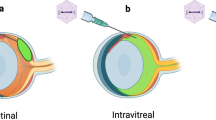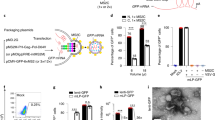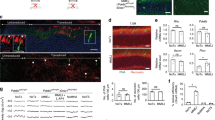Abstract
One of the most disabling forms of retinal degeneration occurs in Usher syndrome, since it affects patients who already suffer from deafness. Mutations in the myosin VIIa gene (MYO7A) cause a major subtype of Usher syndrome, type 1B. Owing to the loss of function nature of Usher 1B and the relatively large size of MYO7A, we investigated a lentiviral-based gene replacement therapy in the retinas of MYO7A-null mice. Among the different promoters tested, a CMV-MYO7A chimeric promoter produced wild-type levels of MYO7A in cultured RPE cells and retinas in vivo. Efficacy of the lentiviral therapy was tested by using cell-based assays to analyze the correction of previously defined, MYO7A-null phenotypes in the mouse retina. In vitro, defects in phagosome digestion and melanosome motility were rescued in primary cultures of RPE cells. In vivo, the normal apical location of melanosomes in RPE cells was restored, and the abnormal accumulation of opsin in the photoreceptor connecting cilium was corrected. These results demonstrate that a lentiviral vector can accommodate a large cDNA, such as MYO7A, and mediate correction of important cellular functions in the retina, a major site affected in the Usher syndrome. Therefore, a lentiviral-mediated gene replacement strategy for Usher 1B therapy in the retina appears feasible.
This is a preview of subscription content, access via your institution
Access options
Subscribe to this journal
Receive 12 print issues and online access
$259.00 per year
only $21.58 per issue
Buy this article
- Purchase on Springer Link
- Instant access to full article PDF
Prices may be subject to local taxes which are calculated during checkout





Similar content being viewed by others
References
Smith RJ, Berlin CI, Hejtmancik JF, Keats BJ, Kimberling WJ, Lewis RA et al. Clinical diagnosis of the Usher syndromes. Usher Syndrome Consortium. Am J Med Genet 1994; 50: 32–38.
Keats BJ, Corey DP . The usher syndromes. Am J Med Genet 1999; 89: 158–166.
Astuto LM, Weston MD, Carney CA, Hoover DM, Cremers CW, Wagenaar M et al. Genetic heterogeneity of Usher syndrome: analysis of 151 families with Usher type I. Am J Hum Genet 2000; 67: 1569–1574.
Bharadwaj AK, Kasztejna JP, Huq S, Berson EL, Dryja TP . Evaluation of the myosin VIIA gene and visual function in patients with Usher syndrome type I. Exp Eye Res 2000; 71: 173–181.
Ouyang XM, Yan D, Du LL, Hejtmancik JF, Jacobson SG, Nance WE et al. Characterization of Usher syndrome type I gene mutations in an Usher syndrome patient population. Hum Genet 2005; 116: 292–299.
Weil D, Blanchard S, Kaplan J, Guilford P, Gibson F, Walsh J et al. Defective myosin VIIA gene responsible for Usher syndrome type 1B. Nature 1995; 374: 60–61.
Hasson T, Heintzelman MB, Santos-Sacchi J, Corey DP, Mooseker MS . Expression in cochlea and retina of myosin VIIa, the gene product defective in Usher syndrome type 1B. Proc Natl Acad Sci USA 1995; 92: 9815–9819.
Wolfrum U, Liu X, Schmitt A, Udovichenko IP, Williams DS . Myosin VIIa as a common component of cilia and microvilli. Cell Motil Cytoskeleton 1998; 40: 261–271.
Gibbs D, Williams DS . Usher 1 protein complexes in the retina. Invest Ophthalmol Vis Sci 2004; 45: e-letter (May 26) http://www.iovs.org/cgi/eletters/44/11/5006.
El-Amraoui A, Schonn JS, Kussel-Andermann P, Blanchard S, Desnos C, Henry JP et al. MyRIP, a novel Rab effector, enables myosin VIIa recruitment to retinal melanosomes. EMBO Rep 2002; 3: 463–470.
Gibbs D, Azarian SM, Lillo C, Kitamoto J, Klomp AE, Steel KP et al. Role of myosin VIIa and Rab27a in the motility and localization of RPE melanosomes. J Cell Sci 2004; 117: 6473–6483.
Liu X, Vansant G, Udovichenko IP, Wolfrum U, Williams DS . Myosin VIIa, the product of the Usher 1B syndrome gene, is concentrated in the connecting cilia of photoreceptor cells. Cell Motil Cytoskel 1997; 37: 240–252.
Gibson F, Walsh J, Mburu P, Varela A, Brown KA, Antonio M et al. A type VII myosin encoded by mouse deafness gene shaker-1. Nature 1995; 374: 62–64.
Mburu P, Liu XZ, Walsh J, Saw D, Jamie M, Cope TV et al. Mutation analysis of the mouse myosin VIIA deafness gene. Genes Funct 1997; 1: 191–203.
Hasson T, Walsh J, Cable J, Mooseker MS, Brown SDM, Steel KP . Effects of shaker-1 mutations on myosin-VIIa protein and mRNA expression. Cell Motil Cytoskeleton 1997; 37: 127–138.
Lillo C, Kitamoto J, Liu X, Quint E, Steel KP, Williams DS . Mouse models for Usher syndrome 1B. Adv Exp Med Biol 2003; 533: 143–150.
Liu X, Ondek B, Williams DS . Mutant myosin VIIa causes defective melanosome distribution in the RPE of shaker-1 mice. Nat Genet 1998; 19: 117–118.
Gibbs D, Kitamoto J, Williams DS . Abnormal phagocytosis by retinal pigmented epithelium that lacks myosin VIIa, the Usher syndrome 1B protein. Proc Natl Acad Sci USA 2003; 100: 6481–6486.
Futter CE, Ramalho JS, Jaissle GB, Seeliger MW, Seabra MC . The role of Rab27a in the regulation of melanosome distribution within retinal pigment epithelial cells. Mol Biol Cell 2004; 15: 2264–2275.
Young RW, Bok D . Participation of the retinal pigment epithelium in the rod outer segment renewal process. J Cell Biol 1969; 42: 392–403.
Bok D, Hall MO . The role of the pigment epithelium in the etiology of inherited retinal dystrophy in the rat. J Cell Biol 1971; 49: 664–682.
Schraermeyer U, Heimann K . Current understanding on the role of retinal pigment epithelium and its pigmentation. Pigment Cell Res 1999; 12: 219–236.
Liu X, Udovichenko IP, Brown SDM, Steel KP, Williams DS . Myosin VIIa participates in opsin transport through the photoreceptor cilium. J Neurosci 1999; 19: 6267–6274.
Acland GM, Aguirre GD, Ray J, Zhang Q, Aleman TS, Cideciyan AV et al. Gene therapy restores vision in a canine model of childhood blindness. Nat Genet 2001; 28: 92–95.
Narfstrom K, Katz ML, Bragadottir R, Seeliger M, Boulanger A, Redmond TM et al. Functional and structural recovery of the retina after gene therapy in the RPE65 null mutation dog. Invest Ophthalmol Vis Sci 2003; 44: 1663–1672.
Dejneka NS, Surace EM, Aleman TS, Cideciyan AV, Lyubarsky A, Savchenko A et al. In utero gene therapy rescues vision in a murine model of congenital blindness. Mol Ther 2004; 9: 182–188.
Lai CM, Yu MJ, Brankov M, Barnett NL, Zhou X, Redmond TM et al. Recombinant adeno-associated virus type 2-mediated gene delivery into the Rpe65-/- knockout mouse eye results in limited rescue. Genet Vaccines Ther 2004; 2: 3.
Pang JJ, Chang B, Kumar A, Nusinowitz S, Noorwez SM, Li J et al. Gene therapy restores vision-dependent behavior as well as retinal structure and function in a mouse model of RPE65 Leber congenital amaurosis. Mol Ther 2006; 13: 565–572.
Acland GM, Aguirre GD, Bennett J, Aleman TS, Cideciyan AV, Bennicelli J et al. Long-term restoration of rod and cone vision by single dose rAAV-mediated gene transfer to the retina in a canine model of childhood blindness. Mol Ther 2005; 12: 1072–1082.
Vollrath D, Feng W, Duncan JL, Yasumura D, D'Cruz PM, Chappelow A et al. Correction of the retinal dystrophy phenotype of the RCS rat by viral gene transfer of Mertk. Proc Natl Acad Sci USA 2001; 98: 12584–12589.
Smith AJ, Schlichtenbrede FC, Tschernutter M, Bainbridge JW, Thrasher AJ, Ali RR . AAV-Mediated gene transfer slows photoreceptor loss in the RCS rat model of retinitis pigmentosa. Mol Ther 2003; 8: 188–195.
Tschernutter M, Schlichtenbrede FC, Howe S, Balaggan KS, Munro PM, Bainbridge JW et al. Long-term preservation of retinal function in the RCS rat model of retinitis pigmentosa following lentivirus-mediated gene therapy. Gene Ther 2005; 12: 694–701.
Kelley PM, Weston MD, Chen ZY, Orten DJ, Hasson T, Overbeck LD et al. The genomic structure of the gene defective in Usher syndrome type Ib (MYO7A). Genomics 1997; 40: 73–79.
Levy G, Levi-Acobas F, Blanchard S, Gerber S, Larget-Piet D, Chenal V et al. Myosin VIIA gene: heterogeneity of the mutations responsible for Usher syndrome type IB. Hum Mol Genet 1997; 6: 111–116.
Verma IM, Weitzman MD . Gene therapy: twenty-first century medicine. Annu Rev Biochem 2005; 74: 711–738.
Dull T, Zufferey R, Kelly M, Mandel RJ, Nguyen M, Trono D et al. A third-generation lentivirus vector with a conditional packaging system. J Virol 1998; 72: 8463–8471.
Pfeifer A, Brandon EP, Kootstra N, Gage FH, Verma IM . Delivery of the Cre recombinase by a self-deleting lentiviral vector: efficient gene targeting in vivo. Proc Natl Acad Sci USA 2001; 98: 11450–11455.
Aiken C . Pseudotyping human immunodeficiency virus type 1 (HIV-1) by the glycoprotein of vesicular stomatitis virus targets HIV-1 entry to an endocytic pathway and suppresses both the requirement for Nef and the sensitivity to cyclosporin A. J Virol 1997; 71: 5871–5877.
Burns JC, Friedmann T, Driever W, Burrascano M, Yee JK . Vesicular stomatitis virus G glycoprotein pseudotyped retroviral vectors: concentration to very high titer and efficient gene transfer into mammalian and nonmammalian cells. Proc Natl Acad Sci USA 1993; 90: 8033–8037.
Grieger JC, Samulski RJ . Packaging capacity of adeno-associated virus serotypes: impact of larger genomes on infectivity and postentry steps. J Virol 2005; 79: 9933–9944.
el-Amraoui A, Sahly I, Picaud S, Sahel J, Abitbol M, Petit C . Human Usher 1B/mouse shaker-1: the retinal phenotype discrepancy explained by the presence/absence of myosin VIIA in the photoreceptor cells. Hum Mol Genet 1996; 5: 1171–1178.
Miyoshi H, Takahashi M, Gage FH, Verma IM . Stable and efficient gene transfer into the retina using an HIV-based lentiviral vector. Proc Natl Acad Sci USA 1997; 94: 10319–10323.
Takahashi M, Miyoshi H, Verma IM, Gage FH . Rescue from photoreceptor degeneration in the rd mouse by human immunodeficiency virus vector-mediated gene transfer. J Virol 1999; 73: 7812–7816.
Gruter O, Kostic C, Crippa SV, Perez MT, Zografos L, Schorderet DF et al. Lentiviral vector-mediated gene transfer in adult mouse photoreceptors is impaired by the presence of a physical barrier. Gene Ther 2005; 12: 942–947.
Bushman FD . Targeting survival: integration site selection by retroviruses and LTR-retrotransposons. Cell 2003; 115: 135–138.
Mitchell RS, Beitzel BF, Schroder AR, Shinn P, Chen H, Berry CC et al. Retroviral DNA integration: ASLV, HIV, and MLV show distinct target site preferences. PLoS Biol 2004; 2: E234.
Kuhn EJ, Geyer PK . Genomic insulators: connecting properties to mechanism. Curr Opin Cell Biol 2003; 15: 259–265.
West AG, Fraser P . Remote control of gene transcription. Hum Mol Genet 2005; 14 (Suppl): R101–R111.
Yanez-Munoz RJ, Balaggan KS, MacNeil A, Howe SJ, Schmidt M, Smith AJ et al. Effective gene therapy with nonintegrating lentiviral vectors. Nat Med 2006; 12: 348–353.
Weng J, Mata NL, Azarian SM, Tzekov RT, Birch DG, Travis GH . Insights into the function of Rim protein in photoreceptors and etiology of Stargardt's disease from the phenotype in abcr knockout mice. Cell 1999; 98: 13–23.
Johnson KR, Gagnon LH, Webb LS, Peters LL, Hawes NL, Chang B et al. Mouse models of USH1C and DFNB18: phenotypic and molecular analyses of two new spontaneous mutations of the Ush1c gene. Hum Mol Genet 2003; 12: 3075–3086.
Libby RT, Kitamoto J, Holme RH, Williams DS, Steel KP . Cdh23 mutations in the mouse are associated with retinal dysfunction but not retinal degeneration. Exp Eye Res 2003; 77: 731–739.
Ball SL, Bardenstein D, Alagramam KN . Assessment of retinal structure and function in Ames waltzer mice. Invest Ophthalmol Vis Sci 2003; 44: 3986–3992.
Faktorovich EG, Steinberg RH, Yasumura D, Matthes MT, LaVail MM . Photoreceptor degeneration in inherited retinal dystrophy delayed by basic fibroblast growth factor. Nature 1990; 347: 83–86.
Zufferey R, Donello JE, Trono D, Hope TJ . Woodchuck hepatitis virus posttranscriptional regulatory element enhances expression of transgenes delivered by retroviral vectors. J Virol 1999; 73: 2886–2892.
Orten DJ, Weston MD, Kelley PM, Cremers CW, Wagenaar M, Jacobson SG et al. Analysis of DNA elements that modulate myosin VIIA expression in humans. Hum Mutat 1999; 14: 354.
Yang X-J . Preparation of Recombinant Retroviruses. In: Rakoczy E (ed). Vision Research Protocols. Human Press: Torowa, NJ, 2001, pp 171–190.
Fields-Berry SC, Halliday AL, Cepko CL . A recombinant retrovirus encoding alkaline phosphatase confirms clonal boundary assignment in lineage analysis of murine retina. Proc Natl Acad Sci USA 1992; 89: 693–697.
Gibbs D, Williams DS . Isolation and culture of primary mouse retinal pigmented epithelial cells. Adv Exp Med Biol 2003; 533: 347–352.
Acknowledgements
We thank Dr Inder Verma for providing the third generation, self-inactivating lentiviral vector, and Dr Tama Hasson for providing the pM7-10a clone, used in the construction of the MYO7A cDNA. This research was supported by grants from the Foundation Fighting Blindness, Research to Prevent Blindness Foundation, and the NIH (EY14440, EY07042, and core Grants EY12598 and EY00331).
Author information
Authors and Affiliations
Corresponding authors
Additional information
Supplementary Information accompanies the paper on Gene Therapy website (http://www.nature.com/gt).
Supplementary information
Rights and permissions
About this article
Cite this article
Hashimoto, T., Gibbs, D., Lillo, C. et al. Lentiviral gene replacement therapy of retinas in a mouse model for Usher syndrome type 1B. Gene Ther 14, 584–594 (2007). https://doi.org/10.1038/sj.gt.3302897
Received:
Revised:
Accepted:
Published:
Issue Date:
DOI: https://doi.org/10.1038/sj.gt.3302897
Keywords
This article is cited by
-
Potential therapeutic strategies for photoreceptor degeneration: the path to restore vision
Journal of Translational Medicine (2022)
-
Ciliary neurotrophic factor-mediated neuroprotection involves enhanced glycolysis and anabolism in degenerating mouse retinas
Nature Communications (2022)
-
Nanomedicine and drug delivery to the retina: current status and implications for gene therapy
Naunyn-Schmiedeberg's Archives of Pharmacology (2022)
-
Lentiviral mediated RPE65 gene transfer in healthy hiPSCs-derived retinal pigment epithelial cells markedly increased RPE65 mRNA, but modestly protein level
Scientific Reports (2020)
-
Whole exome sequencing identifies novel USH2A mutations and confirms Usher syndrome 2 diagnosis in Chinese retinitis pigmentosa patients
Scientific Reports (2019)



